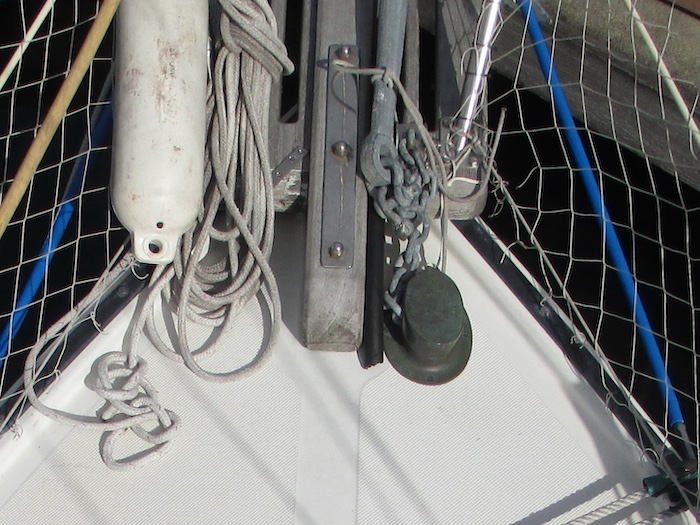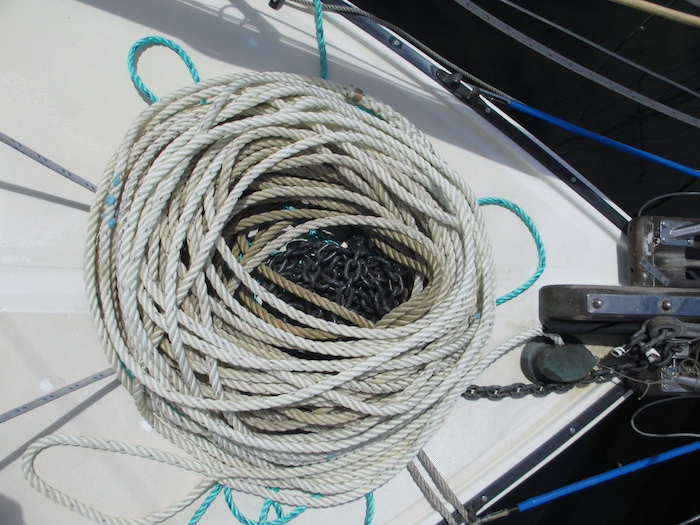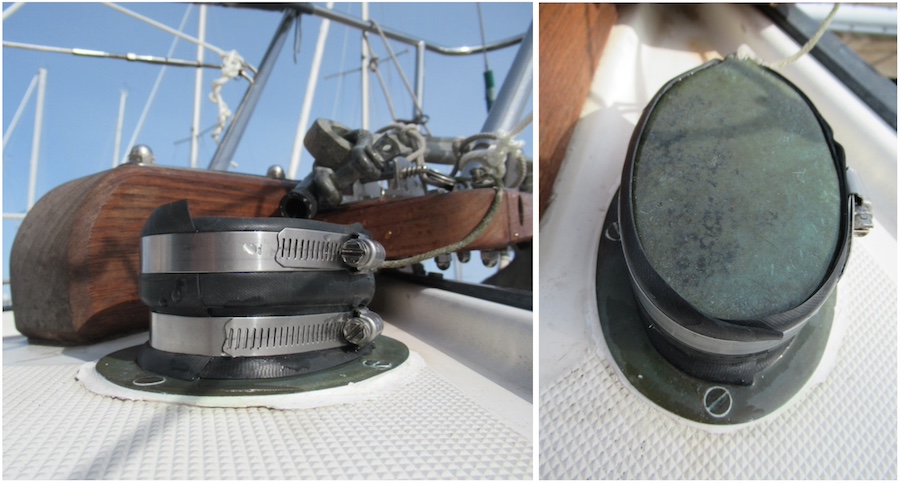
The Resourceful Sailor Asks, “Will You Shut Your Hawsehole?
When The Resourceful Sailor was preparing the 1985 Pacific Seacraft Flicka 20 Sampaguita for offshore sailing, one consideration was sealing up the hawsehole. (What did you call me?) A hawsehole is a hole in the hull the anchor hawser (rode, line, chain, cable) passes through. It allows a weighed anchor kept on the outside to remain connected (and ready for deployment) to a length of hawser on the inside. On Sampaguita, a more accurate description might be a deck hole. (What are you calling me now?)
Hawsehole is an old British naval shippy term, and Sampaguita is a small, modern recreational vessel. Whatever you call it (or me), they present the same problem. There is a substantial hole in the bow of the boat that can allow copious amounts of seawater in, usually when you most want to keep it out. And aboard Sampaguita, this hole needed to be sealed in some manner.

In 10 years of Salish Sea and coastal cruising, Sampaguita’s hawsehole was not a concern. The factory fitting was a bronze oval piece with a flanged lid, held down by the weight of the chain hung from a hook attached to its underside. This applied whether the anchor was deployed or stowed on the bow platform. Once I decided to take an ocean voyage, I felt a need, at least in theory, to seal that hole. (Absolute Rule #1 — keep water out of the boat.) I imagined there were two scenarios. I wanted to make it waterproof with the anchor and chain in place, ready to deploy; and with the two disconnected (and the anchor stowed below).

I’d been on the ocean on other people’s boats and couldn’t recall how this issue was addressed. I queried Google to tempt the vast community knowledge base and came across the idea of using a Nerf football. That sounded intriguing enough to give a try. I bought one for $10 from Amazon to see if I could sort it out. The football, whole, was far too big, so I cut it in half across the middle. Then, it fit uncannily well, cut side down. To accommodate the lid’s hook, I poked a hole through the end of the half-Nerf and pushed it through. The compression of the Nerf was sufficient to keep the lid in place, but I still wanted to hook the chain to the lid so that the end would not get lost deep in the chain locker. I thought I had the solution and would have the other half as a spare. Nope. It certainly mitigated the flow of water, but Nerf is not closed-cell foam, and as I inundated the area with hose water and inspected below, I was unhappy with the water that dripped through. I felt there was a better way.
Though a failed experiment, I learned that the problem with a plug was that while it may prevent water from getting below, it wouldn’t keep water on the outside of the fitting altogether. If water collected inside, I would be uncomfortable with that. The exposed wooden deck core had been gel-coated to mitigate water intrusion when the deck hole and fitting were installed, but I still wanted to keep the area dry and well aerated. So I reasoned it would be better to seal the deck hole fitting from the outside. My next solution was an old bicycle inner tube cut lengthways. I snipped off a small piece to put on the underside of the lid, with the hook poking through, to act as a gasket. With the lid on, I wrapped the rest around the bronze fitting on the outside, spanning it and the base. Then, two right-sized hose clamps, one around the base and one around the lid, were tightened down, creating a seal on the top and bottom. The hose test deemed this a success, and I was satisfied to move on. Did I ever use it? Nope.

The inner tube and the Nerf solutions were designed for the anchor and chain disconnected with the anchor stored below, cinched down tightly in storage under the V-berth. While this was a sound theory, it was something different in practice. I had developed this plan for severe weather. In my voyage down the North American west coast to Mexico, over to the Marquesas, and back to Port Townsend, I never had the need to stow the bower. This is good because the plan I developed while at the dock would have been epic to implement (and un-implement) in a developed sea state.

However, I still needed to keep boarding and splashing waves from entering the hawsehole. Sampaguita’s bilge was often bone-dry. In fact, any water at all meant something was amiss. Murky brown meant mud and rust coming from the chain locker and hawsehole. Under all conditions encountered, an old, too-worn-to-wear-except-alone-at-sea, sun-bleached, salt-encrusted cotton T-shirt wrapped around the outside of the bronze fitting and under and around the chain did the trick.
My previous solutions were available, or I would have improvised an alternate solution if conditions arose, which they did not. In preparing, I applied the theory the best I could imagine. In practice, it turned out to be overkill. But you never know, and to ignore the thought felt imprudent. Different boats present different circumstances to solve, so this is an anecdote as you wonder how to solve for your boat. Those two halves of Nerf? They survived as padding on the flukes of the cockpit locker-stowed Bruce anchor.
Remember, keep your solutions safe and prudent, and have a blast.

I think you mean a spurling pipe. A hawse pipe passes through the topsides. I’ve always solved the problem by plugging the hole with plumbers putty. Keeps the water out but leaves the chain free to run.
Peter,
You roused MORE research. Spurling pipe is a new term for me, and I thank you for that. I didn’t settle on hawsehole and hawse pipe lightly in writing this, trying to land on modern and commercial vernacular. It could be reasoned that Sampaguita has neither, nor a spurling pipe, being so small and without actual pipes or a windlass. (Unless you count me.) Somehow, the “anchor chain deck hole” didn’t have a ring to it either. Many readers would have boats with windlasses and spurling pipes would definitely be correct. I love that I learn new things every day. The Resourceful Sailor’s goal is to create conversation and inspire creative thinking and sharing. You have participated. Thanks for sharing and reading.